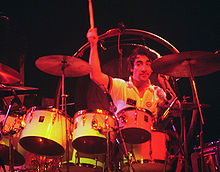The Who are an English rock band formed in 1964. The primary lineup consisted of vocalist Roger Daltrey, guitarist Pete Townshend, bassist John Entwistle, and drummer Keith Moon. They became known for energetic live performances including the pioneering spectacle of instrument destruction.[1][2] The Who have sold about 100 million records and have charted 27 top forty singles in the United Kingdom and United States with 17 top ten albums.[3]
The Who rose to fame in the UK with a series of top ten hit singles, boosted in part by pirate radio stations such as Radio Caroline, beginning in January 1965 with "I Can't Explain". The albums My Generation (1965), A Quick One (1966) and The Who Sell Out (1967) followed, with the first two hitting the UK top five. They first hit the U.S. Top 40 in 1967 with "Happy Jack" and hit the top ten later that year with "I Can See for Miles". Their fame grew with memorable performances at the Monterey Pop[4] and Woodstock[5] music festivals. The 1969 release of Tommy was the first in a series of top ten albums in the U.S., followed by Live at Leeds (1970), Who's Next (1971), Quadrophenia (1973), The Who By Numbers (1975), Who Are You (1978) and The Kids Are Alright (1979).
Moon died at the age of 32 in 1978, after which the band released two studio albums, the UK and U.S. top five Face Dances (1981) and the U.S. top ten It's Hard (1982), with drummer Kenney Jones, before disbanding in 1983. They re-formed at events such as Live Aid and for reunion tours such as their 25th anniversary tour (1989) and the Quadrophenia tours of 1996 and 1997. In 2000, the three surviving original members discussed recording an album of new material, but their plans temporarily stalled upon Entwistle's death at the age of 57 in 2002. Townshend and Daltrey continue to perform as The Who, and in 2006 they released the studio album Endless Wire, which reached the top ten in the UK and U.S.
The Who were inducted into the Rock and Roll Hall of Fame in 1990, their first year of eligibility.[5][6] Their display there describes them as "Prime contenders, in the minds of many, for the title of World's Greatest Rock Band."[7] The Los Angeles Times wrote that during their tenure as a quartet, the band "rivaled The Beatles, Bob Dylan and The Rolling Stones as the most vital rock voice of youth."[8] Time Magazine wrote in 1979 that "No other group has ever pushed rock so far, or asked so much from it."[9] They received a Lifetime Achievement Award from the British Phonographic Industry in 1988,[10] and from the Grammy Foundation in 2001.[11] In 2008 surviving members Townshend and Daltrey were honoured at the 31st Annual Kennedy Center Honors.[12]
Quadrophenia and By Numbers
Who's Next was followed by Quadrophenia (1973), The Who's second completed double album rock opera. The story is about a boy named Jimmy, who struggles for self-esteem, with his family and others, and is mentally ill.[26] His story is set against clashes between Mods and Rockers in the early 1960s in the UK, particularly at Brighton. The album became their highest charting cross-Atlantic success, peaking at #2 in the UK and U.S. The U.S. tour started on 20 November 1973 at the San Francisco, California Cow Palace in Daly City where Moon passed out during "Won't Get Fooled Again" and, after a break backstage, again in "Magic Bus". Townshend asked the audience, "Can anyone play the drums? - I mean somebody good." An audience member, Scot Halpin, filled in for the rest of the show, a jam featuring "Smokestack Lightning", "Spoonful" and "Naked Eye".[27]In 1974 The Who released the outtakes album Odds & Sods, which featured several songs from the aborted Lifehouse project. Their 1975 album, The Who by Numbers, had introspective songs, lightened by "Squeeze Box", another hit single. Some critics considered By Numbers Townshend's "suicide note."[28] A movie version of Tommy released that year was directed by Ken Russell, starred Daltrey and earned Townshend an Academy Award nomination for Best Original Score. In December, The Who set the record for largest indoor concert at the Pontiac Silverdome.[29] In 1976, The Who played at The Valley in what was listed for over a decade in the Guinness Book of World Records as the world's loudest concert.[19]










No comments:
Post a Comment